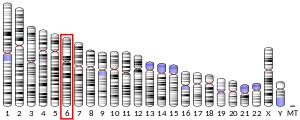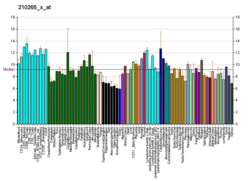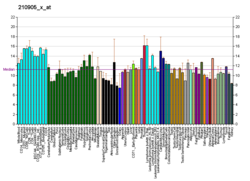Our website is made possible by displaying online advertisements to our visitors.
Please consider supporting us by disabling your ad blocker.
Oct-4
Oct-4 (octamer-binding transcription factor 4), also known as POU5F1 (POU domain, class 5, transcription factor 1), is a protein that in humans is encoded by the POU5F1 gene.[5] Oct-4 is a homeodomain transcription factor of the POU family. It is critically involved in the self-renewal of undifferentiated embryonic stem cells.[6] As such, it is frequently used as a marker for undifferentiated cells. Oct-4 expression must be closely regulated; too much or too little will cause differentiation of the cells.[7]
Octamer-binding transcription factor 4, OCT-4, is a transcription factor protein that is encoded by the POU5F1 gene and is part of the POU (Pit-Oct-Unc) family.[8] OCT-4 consists of an octamer motif, a particular DNA sequence of AGTCAAAT that binds to their target genes and activates or deactivates certain expressions. These gene expressions then lead to phenotypic changes in stem cell differentiation during the development of a mammalian embryo.[9] It plays a vital role in determining the fates of both inner mass cells and embryonic stem cells and has the ability to maintain pluripotency throughout embryonic development.[10] Recently, it has been noted that OCT-4 not only maintains pluripotency in embryonic cells but also has the ability to regulate cancer cell proliferation and can be found in various cancers such as pancreatic, lung, liver and testicular germ cell tumors in adult germ cells.[11] Another defect this gene can have is dysplastic growth in epithelial tissues which are caused by a lack of OCT-4 within the epithelial cells.[12]
- ^ a b c ENSG00000206454, ENSG00000204531, ENSG00000237582, ENSG00000229094, ENSG00000233911, ENSG00000235068 GRCh38: Ensembl release 89: ENSG00000230336, ENSG00000206454, ENSG00000204531, ENSG00000237582, ENSG00000229094, ENSG00000233911, ENSG00000235068 – Ensembl, May 2017
- ^ a b c GRCm38: Ensembl release 89: ENSMUSG00000024406 – Ensembl, May 2017
- ^ "Human PubMed Reference:". National Center for Biotechnology Information, U.S. National Library of Medicine.
- ^ "Mouse PubMed Reference:". National Center for Biotechnology Information, U.S. National Library of Medicine.
- ^ Takeda J, Seino S, Bell GI (September 1992). "Human Oct3 gene family: cDNA sequences, alternative splicing, gene organization, chromosomal location, and expression at low levels in adult tissues". Nucleic Acids Research. 20 (17): 4613–20. doi:10.1093/nar/20.17.4613. PMC 334192. PMID 1408763.
- ^ Boyer LA, Lee TI, Cole MF, Johnstone SE, Levine SS, Zucker JP, et al. (September 2005). "Core transcriptional regulatory circuitry in human embryonic stem cells". Cell. 122 (6). Elsevier BV: 947–956. doi:10.1016/j.cell.2005.08.020. PMC 3006442. PMID 16153702.
- ^ Niwa H, Miyazaki J, Smith AG (April 2000). "Quantitative expression of Oct-3/4 defines differentiation, dedifferentiation or self-renewal of ES cells". Nature Genetics. 24 (4): 372–6. doi:10.1038/74199. PMID 10742100. S2CID 33012290.
- ^ Zeineddine, Dana et al. “The Oct4 protein: more than a magic stemness marker.” American journal of stem cells vol. 3,2 74-82. 5 Sep. 2014
- ^ Pan GJ, Chang ZY, Schöler HR, Pei D (December 2002). "Stem cell pluripotency and transcription factor Oct4". Cell Research. 12 (5–6). Springer Science and Business Media LLC: 321–329. doi:10.1038/sj.cr.7290134. PMID 12528890. S2CID 2982527.
- ^ Wu G, Schöler HR (2014). "Role of Oct4 in the early embryo development". Cell Regeneration. 3 (1). Springer Science and Business Media LLC: 7. doi:10.1186/2045-9769-3-7. PMC 4230828. PMID 25408886.
- ^ Saha SK, Jeong Y, Cho S, Cho SG (October 2018). "Systematic expression alteration analysis of master reprogramming factor OCT4 and its three pseudogenes in human cancer and their prognostic outcomes". Scientific Reports. 8 (1). Springer Science and Business Media LLC: 14806. Bibcode:2018NatSR...814806S. doi:10.1038/s41598-018-33094-7. PMC 6172215. PMID 30287838.
- ^ Hochedlinger K, Yamada Y, Beard C, Jaenisch R (May 2005). "Ectopic expression of Oct-4 blocks progenitor-cell differentiation and causes dysplasia in epithelial tissues". Cell. 121 (3). Elsevier BV: 465–477. doi:10.1016/j.cell.2005.02.018. PMID 15882627. S2CID 1913872.
Previous Page Next Page










